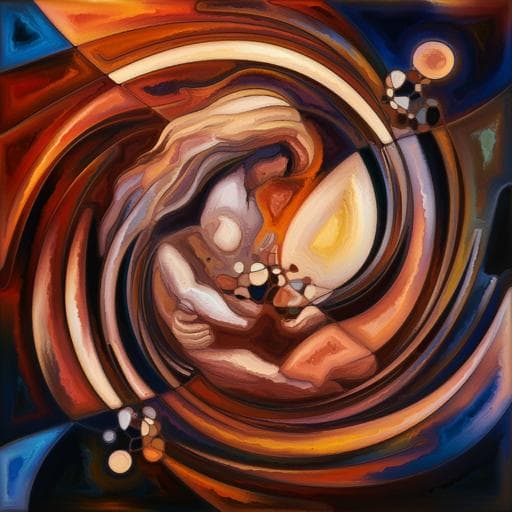
Humanities
The trauma and fragmentation narrative in Amy Tan's *The Kitchen God's Wife* and Toni Morrison's *Beloved*
Y. Yang
Discover the profound exploration of trauma in marginalized communities through the fragmented narratives of Amy Tan's *The Kitchen God's Wife* and Toni Morrison's *Beloved*. This insightful research by Yali Yang delves deep into mother-daughter dynamics, revealing how these narrative forms portray the psychological scars of war and discrimination.
Playback language: English
Introduction
The 20th century witnessed unprecedented upheaval, marked by armed conflicts, the Holocaust, and widespread racial and religious trauma. Trauma theory, emerging in the 1990s, provided a framework for understanding the psychological and societal impact of these events. Building upon psychoanalytic foundations and spurred by the recognition of PTSD, trauma studies expanded to encompass the experiences of marginalized communities. This paper focuses on trauma literature, specifically analyzing how two seminal works – Amy Tan's *The Kitchen God's Wife* and Toni Morrison's *Beloved* – employ fragmented narratives to portray the lasting effects of trauma on mothers and their daughters. Both novels, representative of Asian and African American experiences, explore themes of motherhood, intergenerational trauma, and the struggle for communication and reconciliation within families affected by historical and cultural oppression. The research uses a comparative methodology to contrast the narrative strategies employed in both novels, aiming to illuminate the shared techniques used to depict trauma and their broader implications for trauma studies and a humane understanding of trauma victims.
Literature Review
The paper draws upon existing scholarship in trauma theory and trauma literature. It references key figures like Shoshana Felman, Cathy Caruth, and Judith Herman, highlighting their contributions to understanding trauma's psychological and narrative manifestations. The concept of 'cultural trauma,' as introduced by Jeffrey Alexander, is also relevant, as it broadens the scope of trauma beyond individual experiences to encompass collective societal traumas. The work of Anne Whitehead, connecting trauma theory with literary depictions, provides a crucial lens for analyzing the chosen novels. The paper also acknowledges the limitations of focusing solely on literary form and genre, recognizing the importance of identity politics and other aspects of literary criticism, but justifying the present focus on narrative structure and technique for this particular study.
Methodology
This paper employs a comparative research methodology, analyzing the narrative strategies of *The Kitchen God's Wife* and *Beloved* through the lens of trauma theory. The analysis focuses on two key aspects: (1) fragmentation of narrative structure (flashbacks, delays, repetition) and (2) fragmentation of character.
Regarding narrative structure, the paper examines how the non-linear timelines, shifting perspectives, and intercalated narratives mirror the fragmented nature of traumatic memory. The analysis explores how flashbacks, delays, and repetitions in the novels function to represent the intrusion of traumatic memories into the present, hindering linear storytelling and reflecting the disjointed experience of trauma. Specific examples from both novels are used to illustrate the techniques employed by Tan and Morrison.
The analysis of character fragmentation investigates how the protagonists' identities are fractured, reflecting their internal struggles and alienation. The paper focuses on the portrayal of the mothers (Winnie and Sethe) and the ways in which their fragmented selves are revealed through narrative choices. The concept of the 'inner child' is explored as a tool for understanding the impact of childhood trauma and its influence on the adult lives of the protagonists. The paper discusses how the fragmented character images of both Winnie and Sethe, as well as Beloved, serve as a powerful means of representing the lasting effects of trauma and the challenges of self-discovery and healing. The analysis contrasts the representation of superstition and spiritual elements in each novel, acknowledging differing cultural contexts and their role in shaping the narrative of trauma.
Key Findings
The analysis reveals that both Tan and Morrison skillfully employ fragmented narrative techniques to represent the psychological impact of trauma. The non-linear, fragmented structure of the novels effectively conveys the disjointed and unpredictable nature of traumatic memories. In *The Kitchen God's Wife*, the alternating perspectives of Winnie and Pearl highlight the communication barriers created by unspoken trauma and cultural differences. The fragmented timeline mirrors Winnie's struggle to process and articulate her past experiences, eventually leading to reconciliation with her daughter. In *Beloved*, the fragmented narrative structure, multiple perspectives, and the presence of Beloved as a manifestation of Sethe's trauma create a powerful and haunting representation of the lasting impact of slavery. The analysis reveals how character fragmentation, particularly through the exploration of the concept of the 'inner child,' illuminates the lasting effects of childhood trauma on the adult personalities of Winnie and Sethe. Winnie's fragmented relationship with her own mother deeply impacts her adult life. The 'inner child' concept allows for understanding how these past wounds manifest as vulnerabilities and patterns in their adult lives. In *Beloved*, the character Beloved, a fragmented representation of Sethe's murdered daughter, acts as a physical embodiment of Sethe's trauma, vividly demonstrating how the past continues to haunt the present. The analysis also highlights the role of superstition and spiritual elements in both novels as expressions of the fragmented psychological states of the protagonists. Winnie's superstition mirrors her disjointed mental state, while in Beloved, the ghostly presence of Beloved represents the spiritual trauma of slavery and its haunting effect on Sethe and her family.
Discussion
The findings of this study underscore the power of fragmented narrative as a tool for representing trauma in literature. The non-linear, multi-perspective narratives employed by Tan and Morrison effectively convey the complexities of traumatic experience, demonstrating how trauma disrupts linear time and creates a sense of fragmentation in both memory and identity. The analysis reveals how the fractured narrative structures mirror the psychological impact of trauma on the protagonists, highlighting the challenges of communication, reconciliation, and the ongoing process of healing. This research contributes to the understanding of trauma representation in literature, particularly in the context of marginalized communities. The study's focus on mother-daughter relationships sheds light on the intergenerational transmission of trauma and the enduring effects of historical and cultural oppression. The detailed analysis of fragmented narratives, character portrayals, and the integration of cultural elements like superstition and spirituality offers a nuanced understanding of the complex interplay between individual and collective trauma.
Conclusion
This paper demonstrates how Amy Tan and Toni Morrison utilize fragmented narratives to effectively convey the complex and lasting impact of trauma. The non-linear timelines, shifting perspectives, and fragmented character portrayals in *The Kitchen God's Wife* and *Beloved* mirror the disjointed experience of traumatic memory and the fractured sense of self often experienced by trauma survivors. The analysis emphasizes the significance of understanding these narrative techniques for a deeper appreciation of trauma literature and its contribution to trauma studies. Further research could explore the broader application of fragmented narratives in other literary works and across different cultural contexts, further illuminating the diverse ways in which trauma is experienced and expressed.
Limitations
This study focuses primarily on the narrative structure and character development in *The Kitchen God's Wife* and *Beloved*, limiting a broader exploration of other literary devices or thematic elements. Further, the analysis is limited to two novels, and a larger corpus of works would provide a more comprehensive understanding of trauma representation in literature. The study also primarily focuses on the mothers' experiences, and a more in-depth analysis of the daughters' perspectives might offer further insights. Future research could expand on the limited scope of this paper, examining other relevant literary works and focusing on additional perspectives and themes.
Related Publications
Explore these studies to deepen your understanding of the subject.







